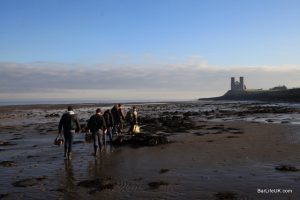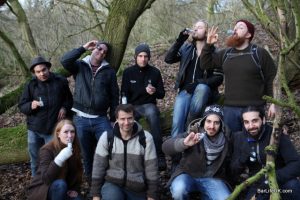Before the sun had cast its warm glow across south east England, before some bartenders had even arrived home after a busy night, a group of intrepid souls gathered in the bitter morning darkness in pre-rush hour Victoria clutching sausage rolls and large cups of coffee.
The day ahead, it seemed, would see this fellowship head into the wild for the first Reyka Expedition.
Fearless leader Joe Petch, in keeping with the spirit of exploration and discovery, had purposefully disseminated as little information as possible regarding the days outline. So naturally, there was a feeling of excitement as we were ushered onto a train which promised to go past stations with unusual and exotic names; Whitstable, Rainham, Sittingbourne, Chestfield & Swalecliffe.
We were greeted at our destination by a minibus and some Reyka supplies including wellington boots, glove liners and our Sherpa and mentor for the day; Fergus the forager. We would be travelling to various sites throughout our journey, beginning at the beach and ending in a forest where we would explore and forage unusual ingredients for a dinner and cocktail session that very evening.
There was certainly a feeling amongst us that we were indeed about to set forth on a quest.
Fergus has coordinated foraging classes for over 25 years and has appeared in a number of TV productions including ‘The Road Kill Chef’. He quickly established himself as a man of passion as he handed us rustic wicker baskets to contain our foraged items.
After a short drive to the coast and, with the wind in our hair, we were ready to begin foraging seaweed on the beautiful stretch of beach known as Herne Bay. There was a quick warning from two locals who crossed our path with regards falling into “sucky mud”, but with our ‘Reyka wellies’ we were ready for anything.
As our feet, used to concrete and beer caps, met with the calm feeling of sand and our lungs filled and expanded with the jagged seaside air we were quickly inspired onto a level of enthusiasm I would normally reserve only for a whisky master class.
Why Did The Sand Blush?
Fergus explained that the UK has access to around 7% of all seaweeds around the world, which roughly constitutes 700 different varieties depending on the season. They can be broken into three categories, Red, Green, Brown and almost all are edible. We are also privileged on our island to have a shoreline with no nuclear power pollution and minimal amounts of industrial waste.
Fergus had prepared several Seaweed delicacies for us including a seaweed jelly and some Gut-weed butter. Gut-weed is actually quite delicious and used normally in many forms of Eastern cuisine, it also owns the slightly more appealing name of ‘Mermaid hair’.
After around an hour we had collected three types, ‘Bladder-ac’, ‘Saw-Rack’ and ‘Dulse’. Fergus assured us that Dulse was going to be the ‘best’ once we deep fried it over a campfire later. So we headed for slightly higher ground as the tide calmly folded in around us.
Fergus carried a large rucksack, which during the course of the day, would become a sort of vortex with an array of homemade syrups, jams, butters, cordials, bitters, potions, elixirs and of course oatcakes. From this bag he produced a series of small jars which he handed out with great fervour and told us that we would be making our personal ‘picked seaweed’.
We used cider vinegar, an optional spoon of sugar, a squeeze of lemon and some pepper and with some Bladder-ac seaweed and we would top up this homemade pickling experiment with different plants throughout the day.
Sea Purslane, which usually grows on salt marsh, was found just past the beach and it was such a hit with all of us that we took five and just sat around enjoying its clean, salty taste in the brisk bright coastal air. It reminded me of Samphire and had a similar shape but a slightly more opaque colour. We even tossed a few into our pickle jars.
From here we wondered past a beautiful Roman period monastery set upon stark cliffs and listened to a master class on pine pollen tinctures and candied fig, of course, out of the rucksack came samples of these very creations, which Fergus had made earlier. This section focussed on extending the use of the plant beyond its traditional range, which was certainly becoming part of expedition’s mission statement.
Phantom Foragers
It was then off to the cliffs where we would pick probably the widest known plants of the day: Sea Buckthorn and Rosehip. It did appear that some phantom foragers had been there before us as the patch was slightly baron, but Fergus explained that we were approaching the end of the season and as the plants became scarce foragers and locals headed down to grab the last few branches.
Sea Buckthorn is the most nutritious berry that is indigenous to Britain, especially high in vitamin C; it had clear cocktail potenial with almost all of us agreeing on a Sea Buckthorn Collins idea. Rosehip also gave us several ideas for concoctions: Fergus had brought with him candied Rosehip, fresh Rosehip syrup, Rosehip concentrate and many other dark red treats to demonstrate its versatility.
By this point all of us were treading very softly and with sharp eyes, scanning every small plant and green tuft emerging from the gourd. This paid off as we left the cliff when we found a massive patch of ‘Alexander’, a member of the carrot family and introduced by the Romans, its bitter taste has left it slightly too powerful for contemporary palates but, this clearly meant that it had useful properties as a component in bitters production. Many were pulled from the ground exposing its signature bone-white root.
Finally after exploring some rare and unexpected flavours it was time for a lunch of sandwiches and Reyka minis. We sat on broken branches on the outskirts of our last port of call; the forest. The sandwiches in question were no ordinary supermarket ‘blandwiches’ but were loving crafted by a known local man ‘Johnny Sandwich’. Fergus was quick to point out that he is less interesting then he sounds.
Lunch brought with it conversation concerning other methods of foraging especially ‘meat foraging’, in particular Fergus’s current project of cat jerky and the worst ‘unusual’ meat he has eaten; owl. Although in fairness to owls everywhere, Fergus is firmly of the option that the owl he prepared was ill before he cooked it.
The forest thickened as we wondered from the path and onto broken twigs and torn leaves. There was a notable air of anticipation; there seemed to be a higher level of familiarisation upon finding edible plants in the forest, than the cliffs or the beach earlier.
Lords and Ladies
We started with a quick chat informing us to avoid at all costs eating a plant called ‘Lords and Ladies’ which is high in oxalic acid and in appearance is close to Sorrel or Rhubarb but actually is identifiable to the untrained eye almost only by an unbroken vein around the edge of the leaf. It imparts a ‘pins and needles’ like sensation to the mouth and lips which can last up to two hours. So naturally, we all took some to hide in everyone else’s dinner later.
Then the time of fungi was upon us. After a quick chocolate covered version from the vortex rucksack which was, naturally, prepared earlier we were instructed to check the ‘Elder wood’ for Witches Butter, a common species of fungi with an ear-like appearance. Yum. Fergus explained that other than being delicious, they had various cosmetic uses.
This led us to a highly anticipated talk on birch wine, The Canadian in me finds any fermented tree sap story very familiar and as we passed around a bottle which had no label that had again, appeared from the vortex rucksack, everyone nodded in agreement at its sweet, and sharp flavour.
We were then schooled on a particularly useful plant: ‘Ale Hoof’. Known for its bitter quality, it was once used for ale production in place of hops, it truly has a great name. Fergus then gave us a few of his favourite names; ‘white horehound’ or marribium vulgare which resembles mint in appearance. I was also quite impressed with ‘glistening ink-cap’, a fungus with a natural dye that was once used in very early ink production.
Finally, with our baskets full of all manner of foraged ingredient and our bodies once again asking for nourishment we drove to the edge of another forest (after stopping at Tesco for cigarettes) where we were meet by a giant red pick-up truck.
We all piled into the back and while passing around a bottle of Reyka, were driven through mud slides straight to the base camp; Reyka had built a woodland paradise, a bar set up with every flavour Joe could fathom in a small all-weather shelter, complete with equipment, fruit and a long dining table garnished with a long and mossy log. All of this had its own tarpaulin ceiling, leaving just enough room to see the stars and a large fire pit, which Fergus quickly lit and begin to prepare our foraged feast.
Campfire Dinner And Drinks
Everyone was eager to get involved, particularly Luca who was put in charge of carving radishes into tiny toadstools. Seaweed risotto, spicy beetroot soup and home-grown apple crumble were on the menu along with a salad which contained many of the plants we’d searched for throughout the day.
The bar, however, was where our anticipation truly began to reveal itself; after spending a whole day talking about using these flavours and plants in drinks, we were finally given the chance. We all jumped on eagerly and started stirring and shaking with our own foraged ingredients and the entire contents of Fergus’ famed vortex rucksack.
Many of the drinks we had discussed and suggested during the day came to fruition as the stars emerged in a night sky which was beautifully free from the shrill sound of sirens. We began experimenting with some recipes which we plan to use later this month at the Reyka bitters launch.
The highlight of the meal was surely the deep fried seaweed. Fergus heated oil straight over the bonfire and warned us to stand back as he threw fist-full after fist-full of all three types we’d foraged that morning into the boiling liquid. The fire show this produced was just a little special and illuminated the faces of the 9 intrepid bartenders, cooking food from the land with a cold glass of Reyka somewhere in the woods; a true day of exploration had been enjoyed by all.
It was a day that reminded me how beautiful the English country side really is, and perhaps, more importantly showed me the bounty and abundance of the larder it freely provides. I’ll raise a glass of Reyka or two for that, again and again.


